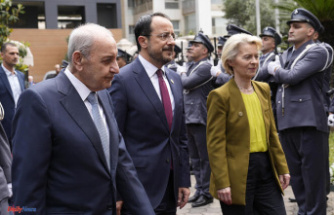Cabu had entrusted 500 of his drawings to the Living Museum of AgroParisTech, an impressive sum of sketches, models, posters, original pages, published in Hara-Kiri, Charlie Hebdo, Liberation, Le Magazine de l'éducation and even made live in Télématin. Sixty-eight of these drawings were selected and unearthed by the association Nîmes s'illustre, supported and accompanied in its choices by the designer's wife, Véronique Cabut. An arduous task, so prolific was the artist. "He was working all the time," she says. Above all, he felt like a journalist and there was always a comment, a reflection behind the laughter, which suddenly turned into a punch in the face. "Cabu is a great defender of the environment and animals, not hesitating to denounce hunting, bullfighting, pollution and mass consumption, and this, from the 1960s! Her colleague and "goddaughter" in the profession, Corinne Rey, known as "Coco", survivor of the Charlie Hebdo attacks, came to discover her and participate in a debate on press cartoons.
Le Point: The exhibition is called "Cabu visionnaire". Would you use the same qualifier to describe it?
Which of the 68 drawings on display appeal to you the most?
I discovered one from 1973 that appeared in the magazine Hara-Kiri: under an apocalyptic setting in shades of pink, a couple congratulated themselves on being able to buy everything by mail order without leaving home. There's also that ink and color watercolor where his smiling, cherries-earringed Duduche goes bald, wears a gas mask, and desiccated pits dangle from his lobes. In 1965, he had fun listing what his character, Duduche, consumed in a year… What's crazy is that he could have drawn them last week. His work is truly timeless, he is a genius.
You talk about him in the present tense... Does he always accompany you?
Of course. I like to continue to see his work, to think of him. Véronique Cabut and the association Nîmes s'illustre have done a magnificent job to arrive at this exhibition. His memory must be maintained.
There is often a seriousness behind the laughter aroused by certain sketches... Was this also the case with the man?
No, he was never serious. He was always even-tempered. He was one of the greatest French designers, and yet he was accessible. He always took the interns under his wing, as he did with me. At Charlie, he brought us every Monday morning the orange cakes he bought at the organic market on the weekends, it was his little ritual. He was sensitive, attentive to others, generous. Imagine, in 1967, he had told in pictures the roundup of the Vél' d'Hiv for a history magazine. He was only 29 years old. Its line is assured, its design so realistic that one would believe photos.
When you met him, during your internship at Charlie Hebdo, were you aware of his personal commitments?
Even before I met him, I loved his work. I knew his drawings on boat people, and his drawings on oil spills, in line with Reiser and his Ecology album. It was also the time of Haroun Tazieff's first climate alerts. Cabu took these subjects very seriously, he was aware of the emergencies.
There was no dead hand against bullfighting and hunters. He would have been inspired these past few weeks!
Especially since the exhibition is in Nîmes, land of feria. It's good to know that he continues to create debate with his drawings. And then it is neither in black humor nor in cynicism, but more in yellow laughter. Which is debatable. Cabu is the designer of nuance: on the same board, he can be sensitive, funny, acid or serious. Never mean. He develops a complete field of drawing, from the elaborate staging to the effective slogan. His very technique is at the service of this search for nuance: black and white can be supplemented by color, by touches. Like in this scene where Duduche is chasing a furry "grandmother" while exclaiming: "That's it, I spotted some otters!" Finally, what is worrying is that these issues of animal suffering are still topical.












